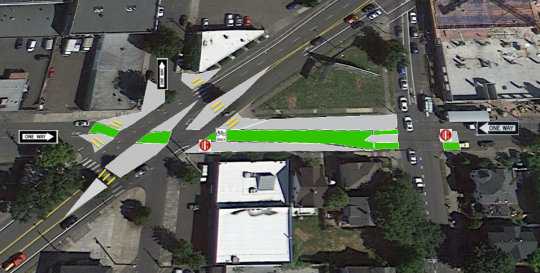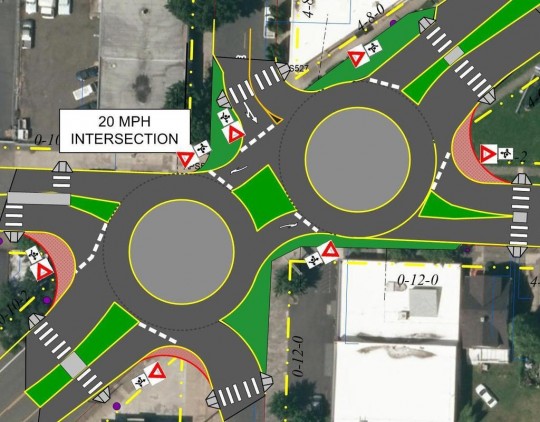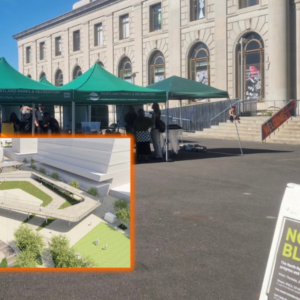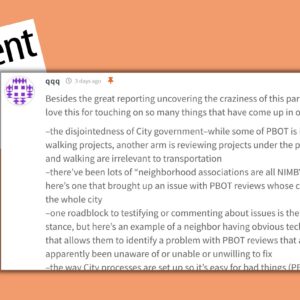One of the great joys of BikePortland comments is that they make very clear how rich and deep our city’s transportation expertise has become over the last decade.
After we wrote on Thursday about a small tweak the city made recently to the strange six-way intersection of SE Ankeny, 11th and Sandy, not one but two readers created full-color overhead mockups of alternative ways to design this awkward interchange.
The first, by reader sean, is a sort of linear park that would remove auto access for one block (immediately south of what is today a billboard) in order to reimagine “Ankeny as a destination”:
This intersection should be a pedestrian Mecca. Here’s what I would want there:
Advertisement
Then, reader paikiala followed up with the double-roundabout design above:
Nice.
I envisioned a couple of low-speed mini-roundabouts that maintained access for all but the largest of trucks. It is a truck district after all.
Sean, some readers may remember, is also the person who created this terrific rethinking of Northwest Johnson Street using successive blocks of one-way traffic and this potentially prescient look at what it would take to create a full north-south bikeway through the Park Blocks from the Broadway Bridge to Portland State University.
Regular comment readers will know that paikiala is no slouch either.
Portland won’t be building either of these until it can somehow find tens of thousands of dollars to spend on improving the spot. But the reason we believe so deeply in this city is that when it can find both money and political will to improve our streets, a huge reservoir of creativity and talent is going to be unleashed.
Yes, we pay for good comments. We’ll be mailing $5 each to Sean and paikiala in thanks for these great ones. Watch your email!










Thanks for reading.
BikePortland has served this community with independent community journalism since 2005. We rely on subscriptions from readers like you to survive. Your financial support is vital in keeping this valuable resource alive and well.
Please subscribe today to strengthen and expand our work.
I also thought of a roundabout idea, but I am concerned that the traffic signal to the east will cause problems. Traffic often backs up well past Ankeney during rush hours. Imagine what will happen with a roundabout: the cars will fill both of the circles, making them impassable for people trying to travel through the circles on Ankeney, or in any other direction for that matter.
Mythbusters has even shown that roundabouts are the most efficient means of handling the highest amount of traffic throughput in the safest, most-predictable manner for busy intersections.
http://tinyurl.com/mythbustersRAB
I like the thought of traffic circles, but I don’t believe the space is available for vehicles to actually make these turn radiuses, even just passenger vehicles. Think of the size of the various manifestations of these types of intersections in the metro area — this would be an exceptionally tight implementation.
The specific design is call a mini-roundabout. The circulating lane is designed for standard autos operating at 15-20 mph maximum. Larger vehicles could use the center truck apron to start or finish turns and through movements. the concept as depicted only needs right of way from the far left side and far right side triangle point properties.
They’re everywhere in Europe. Once people get used to them they’re actually faster and safer than intersections.
The roundabout idea has potential. I’m afraid that, politically, the Central Eastside trucking interests will want to be able to move their largest trucks along this route, both N-S on 7th, as well as southbound on 7th and turn south on 11th. Perhaps an oval roundabout?
Mini-roundabouts are less common in the US, but frequently used in the UK. They are all truck apron. Some examples:
White Center, WA: http://tinyurl.com/white-center-mini
Dimondale, MI: http://tinyurl.com/dimondale-mi-mini
Missoula, MT: Toole and Scott: http://tinyurl.com/mnwnrml
San Buenaventura, CA: http://tinyurl.com/sbv-ca-mini
Anacortes, WA: http://tinyurl.com/AnacortesMini
Unique: http://tinyurl.com/steamconvoy
Sean’s “pedestrian mecca” idea is excellent. I want to send him $5. I wish there was an inexpensive way for the city to test it for a weekend ala the Old Town plaza.
Maybe there is?
I liked it as well. Access to the private garage might be an issue, but a similar thing happened on the Holman greenway at 13th.
Short term, one way with contraflow bike:
http://i1056.photobucket.com/albums/t365/Paikiala/ankeny%2011th%20to%2012th%201WAY%20EBND%20WBND%20CONTRA_zpsyl3qniqy.jpg
Holman west of 13th:
https://goo.gl/maps/g9JDU
I really like the design of this intersection. This concept of incorporating a park in a diverter should be multiplied many times on greenways. Holman btwn 8th and 9th needs the same or at least a 1-way. It’s way too narrow and busy for current traffic.
Does this mean a place to where pedestrians would make a pilgrimage, as some to to the city of Mecca? The term makes no sense to me.
Lowercase “mecca” is not the same as uppercase “Mecca”.
The top concept would be awesome. It’s essentially a supersized traffic diverter like those at Lincoln and Clinton at Cesar Chavez. If the goal to reduce auto traffic on Ankeny, this would seem to be a perfect solution. Auto traffic can still navigate the area, but it reduces the tendency to think of it as an alternate arterial route for Burnside. Though the double roundabout is a laudable effort, it’s rather complex and would confuse a great number of people using all sorts of modes.
It’s incredibly awesome that two people spent the time to come up with ideas for improving that intersection, which definitely needs major improvements.
However, I don’t think roundabouts are the right answer. I come from the UK, where traffic engineers seem to believe that roundabouts are the correct answer to every problem. Although they increase the flow through an intersection (particularly at complicated ones like this) they do so at the expense of the amount of land they take up. That might be OK in low density suburbs, but I fundamentally don’t believe that roundabouts belong in our city centers. As an example, see this lovely piece of urban design in Glasgow (https://goo.gl/maps/JJXZA), completed less than 10 years ago, within a mile of the city center.
Many people confuse other and older styles of circular intersections with modern roundabouts. East coast US rotaries, large multi-lane traffic circles (Arc D’Triomphe, Dupont Circle), and small neighborhood traffic circles are not modern roundabouts. If you want to see the difference between a traffic circle, a rotary (UK roundabout) and a modern roundabout (UK continental roundabout), go to http://tinyurl.com/kstate-RAB to see pictures. And here’s another site that shows the difference between an older rotary and a modern roundabout: http://tinyurl.com/bzf7qmg.
Mini-roundabouts are less common in the US, but frequently used in the UK. They are all truck apron. Some examples:
White Center, WA: http://tinyurl.com/white-center-mini
Dimondale, MI: http://tinyurl.com/dimondale-mi-mini
Missoula, MT: Toole and Scott: http://tinyurl.com/mnwnrml
San Buenaventura, CA: http://tinyurl.com/sbv-ca-mini
Anacortes, WA: http://tinyurl.com/AnacortesMini
As I mentioned, I’m from the UK, so am quite familiar with what a roundabout looks like. In my 24 years of living there I literally never saw one there that made for a great experience for pedestrians or cyclists.
There are good designs though, and sometimes people will post examples from the Netherlands or other more bike/ped friendly countries. However these always take up huge amounts of land to get the physical separation for three modes. That might be a good solution for some of the terrifying intersections in suburban Washington County, but not for inner Portland.
(but to be fair – Anacortes’ roundabout is absolutely useless.)
We should also be comparing towns of the same population/density. It doesn’t make much sense to be comparing towns of 15-18k with Portland 550K+. The traffic is simply comparing apples to candlesticks. Not even in the same section of the grocery store.
I wasn’t comparing towns, I was providing examples of mini-roundabouts in the US.
I like the park idea. It’s effective, easy and follows the KISS principle.
It’s really hard to visualize how the roundabouts would work in real life, looks like a huge congestion problem to me as drivers press for the right of ways in every possible direction..
Though I do like the potential of some big, cool public art spanning the islands.
I also really like the pedestrian mecca concept, especially the split bike entrance / exit on the Eastern side.
Michael’s Sausage would undoubtedly vociferously oppose either of these changes…
Who is Michael and why would his–oh, it’s a restaurant.
Perhaps. I think if a new park at the Ankeny triangle (it’s currently private property owned by Comcast? I believe) were created across the street from him, he might change his mind.
The parking lot adjacent to Michaels will house a 6-story 80 unit apt building, removing the current parking lot. If he wants to stay, he may have to reconsider his stance vis a vis people on bikes.
See this 2009 BP article:
http://bikeportland.org/2009/10/14/bikes-and-the-bad-for-business-rap-24498
The removal of most of Michaels’ off-street parking (which it is interesting to see, was on land he didn’t own), could change his tune, or not!
Michael Zokoych raised a big stink back in 1996, famously stating that his customers were hard-working folks, who were too tired at the end of the day to bike home. He was sure the bike lanes on Sandy would kill his business. To placate him, Mayor Adams (?) put him on the city’s Transportation Bureau Advisory Committee, where he still is, AFAIK.
Which of these concepts will accommodate the #70 bus that uses 11th Ave?
Both.
In general, roundabouts have been shown to be less safe for cyclists but can definitely be made to accommodate bike riders. I am studying a double one like that in England and it works surprisingly well–including for cyclists. It really slows people down and makes them communicate and think. The yielding behavior for drivers has been impressive. It’s also on a trucking route (I’ve never seen so many big rigs in an intersection all at once) and traffic flows significantly better than it did with traffic signals.
Modern roundabouts are very safe for cyclists. The best modern roundabout design for cyclists provides two choices. The more confident cyclist should merge with through traffic and circulate like a motorist. This is made easier by the low-speed operational environment of the modern roundabout, which should not exceed 20 mph (30 kph).
The less confident cyclist should be provided a ramp to exit the street and use a shared use path around the roundabout. Such paths should be at least ten feet wide (3 m) and cyclist operate at low speeds, crossing at the pedestrian crossings. http://tinyurl.com/roundabouts-and-bikes Sometimes space constraints, as with other intersection types, limit ideal design.
Bikes in roundabouts videos:
Clearwater Beach, Florida: http://vimeo.com/54317041
La Jolla, California : http://vimeo.com/61988764
Washington: http://tinyurl.com/reidmiddletonRAB
Bend, Oregon: http://tinyurl.com/bikesRABBendOR
New York DOT: http://tinyurl.com/bikeRABNYdot
Roundabouts? Yes. Double roundabout? I don’t know. I love the creativity of both of these proposals and hope that the professional traffic engineers are willing to take these ideas under consideration.
For those interested in roundabouts at the “deep magic” level consider reading Roundabouts: An Informational Guide – Second Edition.
It is only 407 pages long but starts out slowly introducing the reader to concepts, vocabulary and examples of poor past implementations that cloud our judgment.
By the time you are in the engineering section you won’t even notice that you are now able to judge the intended travel speed of your neighborhood roundabout by inner circle diameter alone.
“starts out slowly”……
Well, I read technical, scientific white papers and engineering manuals for fun and go through them like popcorn.
(this is where normal people usually mumble “freak” and I just shrug my shoulders)
It doesn’t get in to the dense technical stuff until you get in to the 2nd half. Much of the 1st half seems to be dedicated to talking road designers out of anti-roundabout prejudice fostered by poor examples and outright design level sabotage in the mid 20th century.
I love how the double roundabout fixes all of the acute angle turns.
No do not enter signs required, no no left turn signs required.
I’m surprised not to see outrage here over mixing cars with bikes, which is what roundabouts do. Just go ride the one in The Dalles and you’ll see. OK surprised and pleased, that is.
Huge fan of paikiala’s comments, btw, have learned lots.
At 15-20 mph many more safe interactions are possible. The roundabout essentially equalizes all legs of the intersection.
No need to go as far as the Dalles. Portland has two modern roundabouts. One at the airport long term parking and another at Lewis and Clark Law School, SW Terwilliger and Palater.
Those designs look like something the City produces. Great work, except the roundabouts look like something only a true advocate would love.
Ideally almost every intersection would create a space where all road users rarely stop per se, but always travel less than 5 mph. Paikiala’s space reminds people in cars that they have no priority over other road users.
That’s because paikiala is a PBOT engineer!
How about some vegetation in the round abouts, perhaps to manage urban stormwater run-off while further calming traffic?
The center space, as depicted, is for trucks to drive over. It could be grasscrete or other permeable surface, but a depressed space would make it easier to go faster around the circle. negative superelevation (outward banking curves) causes people driving to slow more.
Why not an “oval-about” rather than two circles to make it less confusing. One could make the larger center a nice rainwater run-off collector.
Straighter sections of roadway permit higher speeds and the goal with modern roundabouts is everyone going less than 20 mph.
I’d like to see your ideas for improvements at the SE 11th / 12th / Clinton / Milwaukee. Add a few train tracks to the mix….
11th and 12th would be ideal for the change that occurred on Williams/Vancouver.
One big problem with roundabouts that i haven’t seen mentioned is the very real potential to exclude drivers approaching from the “less busy” entrance points during rush hour. For example, imagine a line of cars entering the roundabout at the 9 o-clock position and exiting at the 3 o-clock position (essentially driving “through” the roundabout). A car waiting to enter at the bottom (the 6 o-clock) position would be met with a continuous stream of cars already in the roundabout and would simply not be able to join in, unless, of course, one of the cars already in the roundabout decided to be “nice” and yield. This happened to me all of the time when i lived in Sydney, a city with lots of roundabouts. Frustrating as hell, and the only way i wold be able to proceed was to slowly nudge (force) my way in until somebody in the circle slowed down and let me in, i.e. essentially playing “chicken” with he other drivers. I usually cussed a lot during those moments.
The fix to this is culture. The best way to change the driving culture in this regard is to have more roundabouts. When people get used to them they start to figure things out. People coming from the lower traffic side need to get over the idea of coming to a complete stop. Instead, slow as approaching, time the vehicles coming through and merge in at the same time, know that the driver approaching from the main street will have to slow down a bit to navigate the roundabout.
Your observations match much of what I’ve read. Roundabouts work pretty well when the volumes of traffic entering are roughly the same from all directions. When there’s a huge imbalance, as there would be here, one encounters exactly the situation you describe. Volumes here are not very similar. Add the complexity of the dual roundabout separated by about one car length, and I don’t know how it would work. Count me as skeptical.
Untrue. This only occurs when one direction is significantly greater than the others. The solution is the same for a signal or a modern roundabout, more lanes for that path.
As for gaps, anytime one person on the mainline/busier direction makes a left, they would stop the mainline from the opposing direction, and a gap is created for the side street. Any right turners create a downstream gap as well. If a through entry from north or south gets in, they block the approaching mainline from their right. It is very organic to watch.
The dual “magic” roundabout design is a fabulous way to handle two oddly offset intersections…assuming that the local jurisdiction in not willing to fully pedestrianize / “naked street” it…and as long as the design makes sure each leg has a queue space and the speed is even lower than the “20 mph” noted on the proposal…15 mph would be max.
The difficulty of doing this “here”…is the state of traffic engineering practice in the US is still far behind what Europe has in this niche of intersection design. AND we have to make sure it meets ADA …that persons with no/ low vision etc. can travel through these intersections with traffic noise coming from all directions (the max speed of 15 mph helps with improved driver yielding to the “white cane” etc.)
PS> Another reader mentioned oval roundabouts…The “oval” type of roundabout is more often used at smaller “traffic circles” where you have a minor (narrow) street intersecting with a arterial (wider) street.
Noise is low at a modern roundabout intersection. Blind people usually use noise to tell if drivers are stopping, or which direction is moving. Fountains or other background noise that masks traffic noise would be an issue.
This video is worth the time:
Poynton, UK: http://tinyurl.com/l6cz27e
The biggest problem I see with both designs is people that want to stay on 11th. For instance, I work on 11th on the NE side but often head to SE, and take classes just a few blocks away on 11th. To continue to head straight, from what I understand, if I were to take the roundabout I have to take half a circle, then 3/4 of the 2nd one before exiting instead of just closing my eyes, praying and shooting straight across. If I were most other people I see around the calming dividers up in NE towards Hollywood area. I’d just shoot diagonally against traffic like a madwoman. But I’m not… Same thing with the parklet idea. From what I can tell it completely makes it impossible for road users to go straight across to continue on 11th. But what’s to keep people from just jaunting straight across like they do on that awkward intersection on 60thish and Halsey every freaking day?
Just some devils advocating for you fellow junior city planners!
I agree that the movement from NE12th SB to SE11th is the biggest challenge. What if 12th becomes one-way NB between Burnside and Couch. That would divert SB traffic to Couch then 11th. The SW-bound lane of Sandy could be closed and re-purposed in a linear mini-park or something.
Not sure I followed all of that, but the light grey area is raised up, and intended for truck use, so the surface could be uncomfortably rough for all but the largest of vehicles expected to drive over it.
Otherwise, the same things that keep people from running red lights or stop signs is what would prevent the behavior you describe.
If I understand your comment, for the park option you could either stop at either pedestrian crossing and walk your bike across, or simply do what you would normally as you take 11th southbound: take the lane.
This brings up a good point. I would actually recommend a stop sign for the left turn lane on Sandy. I see people trying to make that turn threading the needle between northbound traffic on Sandy. I think this gives people on bikes the peace of mind that cars will have to yield (by stopping) to them if they are already in the intersection.
Traffic circles would add 8 STOP signs this is Portland
And then position officers to ticket cyclists running them… 😉
But traffic circles run smoother than having stop lights, since the stopping period gets reduced by the better traffic flow.
Skid,
roundabouts don’t have stop signs, they have yield signs.
And even at that pedestrians would not feel safe. I’ve had drivers at Cole Circle stop at the stop sign and then almost hit me in the adjacent crosswalk.
I agree. Studies have shown that drivers ENTERING a roundabout are pretty good about stopping for pedestrians, but drivers EXITING a roundabout are really bad about yielding to pedestrians.
That depends on the roundabout design.
Doug,
All modern roundabouts have median islands separating incoming and outgoing auto traffic. Pedestrians don’t have to find a gap in two directions of traffic, just one. This is safer for pedestrians, especially for younger or older ones, because they only have to concentrate on one direction of traffic at a time. This is what is meant by two-phase. Cross the first half, pause if you need to, then cross the second half. On multi-lane crossings pedestrian beacons or signals are often added if the auto (or pedestrian) traffic is too numerous. Here is a video example: http://tinyurl.com/rabPHB . The signals can also be two phase, requiring the pedestrian to push a second button when they get to the median. The median can also have a Z path to reorient the pedestrian to view oncoming traffic. Also, the signals usually rest in off, so they are only activated if a pedestrian needs the help crossing. This way only motorists that need to stop are delayed.
Good place for an elevated bike lane, up over the traffic…
I agree with the roundabout concept. This is a longer video, but an idea like this brought all kinds of growth to Poynton (UK). It is worth watching!
https://www.youtube.com/watch?v=-vzDDMzq7d0
Having been through a few busy and not so busy round-a-bouts in Europe, I like them for biking. You merge with traffic and follow through like everybody else and there is very little chance for crossing paths. Here in the U.S. were bikes are routed out of the intersection, they are very dangerous. Drivers exiting the round-a-bout right hook riders and pedestrians going straight. If you are in the lane you are golden. If you are following the designated bike facility you’re toast.
It’s nearly impossible to right hook a cyclist at a modern roundabout since the exit and crosswalk are at least 20 feet apart and vehicle speeds are 20 mph or less.
Wow. Nice work! I love the roundabout concept. In addition to improving traffic flow they can enhance bicycle and pedestrian safety if done right – namely single lanes and low speed – such is the case here. See – http://www.pedbikeinfo.org/data/faq_details.cfm?id=3454. As has been pointed out they do take up space, but that is not an issue when you already have the necessary right of way – such is also the case here. Plus, the traffic circles make convenient locations for stormwater planters which complements the improvements already made to this corridor.